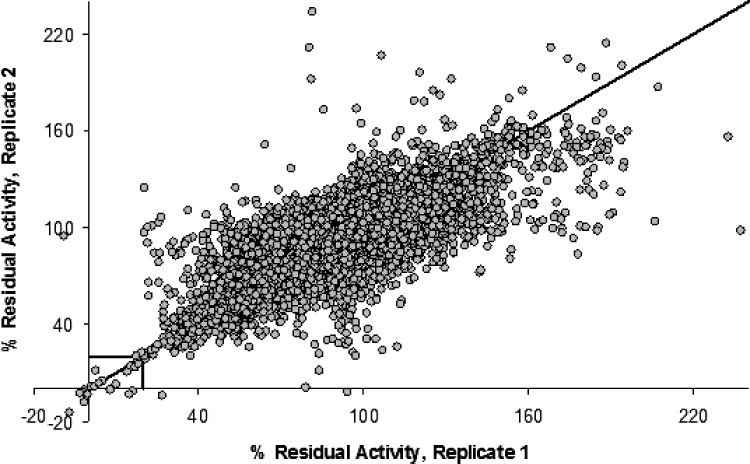Escherichia coli
CAS number: 68583-22-2
A species of gram-negative, facultatively anaerobic, rod-shaped bacteria (GRAM-NEGATIVE FACULTATIVELY ANAEROBIC RODS) commonly found in the lower part of the intestine of warm-blooded animals. It is usually nonpathogenic, but some strains are known to produce DIARRHEA and pyogenic infections. Pathogenic strains (virotypes) are classified by their specific pathogenic mechanisms such as toxins (ENTEROTOXIGENIC ESCHERICHIA COLI), etc.
Related images

Results of the high-throughput screen of E. coli CBL vs 50 000 small molecules.
Related Questions and Answers
A: The study identified a total of 57 VOCs from the susceptible strain and 41 from the resistant strain of E. coli. The VOCs were categorized based on their emission patterns during bacterial growth:
Continuous Release Proportional to Bacterial Load: Compounds like ethanol, 1-propanol, and 1-butanol were released in quantities directly proportional to the bacterial load. These compounds are likely useful for monitoring the progression of an infection.
Temporary Maximum Release: Compounds such as isoprene, 2-butenal, and dimethyl disulfide showed a temporary peak in emission during the logarithmic growth phase. These VOCs could serve as early indicators of bacterial infections.
Compound Uptake: Aldehydes like methacrolein and 3-methylbutanal were taken up by the bacteria, indicating their use as a nutrient source.
Continuous Release Proportional to Bacterial Load: Compounds like ethanol, 1-propanol, and 1-butanol were released in quantities directly proportional to the bacterial load. These compounds are likely useful for monitoring the progression of an infection.
Temporary Maximum Release: Compounds such as isoprene, 2-butenal, and dimethyl disulfide showed a temporary peak in emission during the logarithmic growth phase. These VOCs could serve as early indicators of bacterial infections.
Compound Uptake: Aldehydes like methacrolein and 3-methylbutanal were taken up by the bacteria, indicating their use as a nutrient source.
A: The NMN biosynthetic pathway was implemented in E. coli by expressing PyNP and NRK in a cytidine-producing strain. Optimization of induction and fermentation conditions led to NMN production reaching 33.71 mg/L, demonstrating the functional implementation of the pathway in vivo.
A: Biofilm formation by E. coli significantly reduces the penetration rate of antimicrobial agents by more than 80%, effectively evading immune clearance and leading to persistent infections. This results in severe treatment resistance and recurrent infections, making biofilm-associated infections particularly challenging to treat. The study highlights the need for novel therapeutic strategies, such as the use of natural compounds like Ferulic Acid (FA), to inhibit biofilm formation and enhance the efficacy of conventional antibiotics.
A: E. coli, especially the O157:H7 serotype, poses a significant threat to human and animal health due to its ability to form biofilms. Biofilms enhance bacterial virulence and reduce antibiotic sensitivity, leading to severe treatment resistance and recurrent infections. The formation of biofilms on medical devices and food processing surfaces can lead to hospital-acquired infections and foodborne illnesses, respectively.